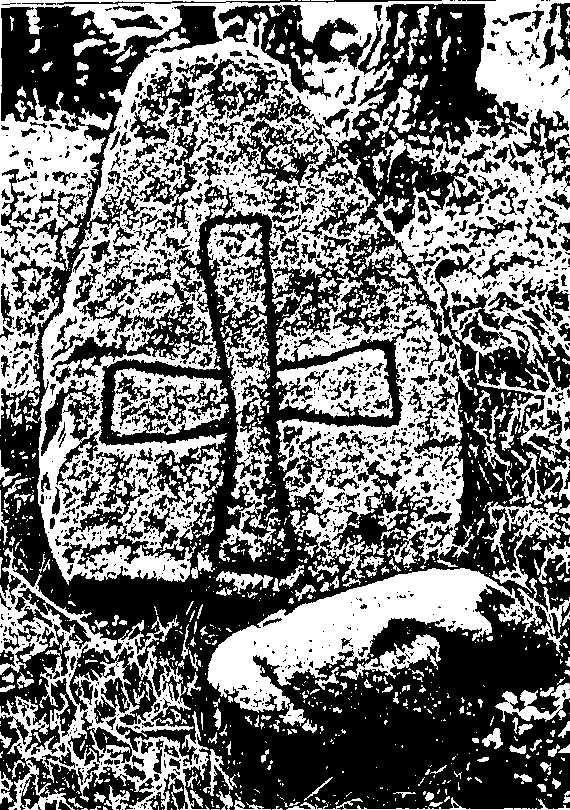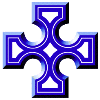As if this is not enough to raise the eyebrows, the reader should also consider the fact that the more accepted site of St. Machar's "cell" lies a little west of Aboyne, some considerable distance from Aberdeen! Mochumma's principal cell was on the side of Balnagowan Hill just west of Aboyne Castle. Here was to be seen Cathair Mochrieha, St. Machar's Chair (a huge rock sadly now broken) and St. Machar's Well. Most interesting of all, there is an ancient dedication cross, incised into a granite boulder, known as St. Machar's Cross (illustrated above). Aboyne may seem a strangely remote place to us now but the reader should remember that in these very early times the main 'roads' were not as we know them now. One of the most important routes from Morayshire came over the Cabrach and crossed the formidable obstacle of the River Dee either at Aboyne or at Kincardine O'Neil. The choice was up to the traveller, but most chose the Kincardine O'Neil crossing. It is interesting to note that the first bridge over the Dee, a wooden structure, was built at the popular Kincardine O'Neil crossing. In these earlier times, there was a substantial Pictish settlement on the hillside above the crossing, as is evidenced by the tumulus, hut circles and cairns nearby. Indeed, some scholars would argue that there was, at that time, a larger and more important secular settlement here than there was at Old Aberdeen! St. Machar chose a site which was, as it turns out, very much on the main road!
All this seems quite simple to understand - except .....! If we were to put the evidence to test in a court of law then we would have a major problem. Not one mention is made of Machar, Mochumma or Mochrieha in the ancient biographies of St. Columba1! The most famous of these is the Life written by a later abbot of Iona, St. Adomnán. He wrote this Life at a time when there were still monks alive who had known St. Columba and his followers personally. In the whole of this vast collection of stories about the life of Colum Cille there is not one mention of Machar. More importantly, as stated above, he is not listed by Adamnán amongst "the twelve" who accompanied St. Columba from Ireland to exile in Iona. (see below)
It is said that one of Mochumma’s close friends was Devenich and it has been suggested that he accompanied Mochumma on his journey to the Picts of the north-east - hence the area known at present as Banchory-Devenick. Banchor means a religious community which was also a major seat of learning for the people of the area. (It is the same word as Bangor.)
A great deal of what we have been told of St. Machar comes from the Aberdeen Breviary and, in itself, this should sound a note of caution. The ancient Pictish church was well established in Aberdeenshire by the time that the barbaric tribes of the Ghaidhealic people of Ireland were only just being introduced to Christianity in the post-Patrician era. St. Ninian and his pupil and successor St. Ternan had established a Bangor on the banks of the River Dee housing manuscripts of the Gospels, and a school, at a time when St. Caranoc, St. Ninian's other pupil, was striving in Columba's native Donegal to win from paganism the very tribes of the Nialls of Ulster from whom St. Columba, in another and later century was born. However, when the old Pictish church was romanised in later centuries everything possible was done to denigrate or, at least, conceal the early missionary work of these Pictish saints. By tradition, the churches founded by them were known by their founder's by name, only to be 're-dedicated' in these later centuries to saints who would be more acceptable to the Roman church. An entirely new form of church organisation, based on geographical diocese and ruled in an hierarchical way by diocesan bishops, was introduced and it is perhaps to the very temporal aims of these bishops that we owe a great deal of the doubtful records of the time - items such as the Aberdeen Breviary. Gone were the days of the great Celtic tradition; of the old saints happy in their muinntirs, at one with their God and nature. It took time for the Roman church to completely win the day but, with the help of the Scottish throne, even the last vestiges, the Culdee communities, were all but gone by the time that the great cathedral and monastic foundations were being built. Some would argue that it was at this time that Scotland lost its true church and that the Second Reformation (c.1560), full of anger and destruction as it was, was still a mere ripple on the waters by comparison.
Bot in this land we ken
hym nocht
Quhare he wondir werkis
wrocht 2
Notes.
1. A list of Columba's companions from Eire is given in Manuscript B of Adamnán's Life and is:
- Baithéne (also called Conin), brother of Cobthach. He succeeded Columba as Abbot of Hy.
- Cobthach, brother of Baithéne.
- Ernán, uncle of St Columba; brother of Columba's mother Æthna.
- Dairmait, Columba's servant.
- Rus, son of Ruadán, brother of Fiachna.
- Fichna, son of Ruadán, brother of Rus.
- Scandal mac Bresail maic Énda maic Néill.
- Lugaid moccu Temnae.
- Eochaid.
- Tochannu moccu Fir Chete.
- Carnán mac Branduib maic Meilgi.
- Grillán.
2. Metcalf, W.M. (1904) The Legends of SS. Ninian and Machor, from an Unique MS. in the Scottish Dialect of the Fourteenth Century, Paisley: Alexander Gardner. [https://archive.org/details/cu31924013511369]
The more complete quotation is:
Bot in this land we ken him nocht,
Quhare he wondir werkis wrocht,
As I sal schortly tel sum thing,
Begynnand fyrst at his gettyng,
And of his byrth, and hou that he
Schupe hym to God plesand to be.
There is a very interesting article written by Tom Turpie - North-Eastern Saints in the Aberdeen Breviary and the "Historia Gentis Scotorum" of Hector Boece: Liturgy, History and Religious Practice in Late Medieval Scotland - which is available online at https://www.academia.edu/36079316/North_Eastern_Saints_in_the_Aberdeen_Breviary_and_the_Historia_Gentis_Scotorum_of_Hector_Boece_Liturgy_History_and_Religious_Practice_in_Late_Medieval_Scotland. It provides excellent background material for the student of St. Drostán.
small(transp).png)

